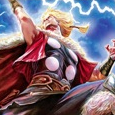Studio (2009), Warner Home Video (March 24, 2009), 1 disc (plus digital copy), 26 mins plus supplements, 2.4:1 ratio, Dolby Digital 5.1/Dolby TrueHD 5.1, Rated R, Retail: $35.99
Storyboard:
The lone survivor of a pirate attack makes his way back home to fend off the buccaneers before they can murder his friends and family, but his own madness leads him to dark deeds of his own. Based on a tale found in the Watchmen comic book series.
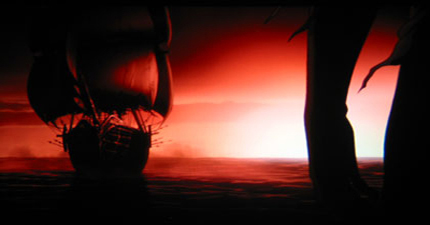
The Sweatbox Review:
I read Watchmen when it was first released as a comic book in 1986-87. It was a cool story, I thought, but seriously— what was the deal with that pirate story? Right? I was really enjoying the dark and multi-layered tale of superheroes influencing the world, wrapped up in a murder mystery, but the creators kept interrupting the narrative with a story-within-a-story— some pirate tale from a comic book being read by some kid at a newsstand. I just didn’t get it. But then, I was just a dumb sixteen-year old. Flash forward a few years, and I decided to re-read the story. I thought I’d be smart and just barely skim through the pirate stuff. Smart, eh?
I upgraded to the deluxe version of the story when Absolute Watchmen was released as a huge, slipcased collector’s edition a couple of years back. It stayed on my shelf unread, though, until a few weeks ago. (I used to have the Graphitti Designs limited edition, too, but sold it on eBay eventually for big bucks without ever reading it.) With the live action adaptation coming out this year, I knew I had to take the opportunity to pull Absolute Watchmen off the shelf and give it a good read. Every word— even the pirate stuff.
And—?

Wow, I so get it! It all seems so obvious now. Boy, I was dumb at sixteen. (Don’t ever tell my dad that I’m admitting it now!)
Tales Of The Black Freighter, the pirate story, serves as an allegory for what is happening in the main story of superheroes racing Armageddon. The thing is, you can’t fully “get it” until you have read through the whole thing once. Until you know who the “villain” of the story is, you couldn’t possibly understand how Tales Of The Black Freighter reveals his motivations and questions his sanity. Truthfully, I’m still torn on whether or not I like having Black Freighter in the comic, but it is what it is, and at least now I understand it better. What’s more important, for the sake of our discussion, is that Zack Snyder understood how important Watchmen: Tales Of The Black Freighter was to Watchmen.
Snyder took the job of directing the Watchmen film adaptation not so much because he really wanted to do it, but because he was afraid that anyone else might really screw it up. Snyder knew the book, and knew it had been considered by many to be unfilmable. With its dense layers of plot, literary devices, and graphic storytelling tricks, there would have to be compromises made— maybe even massive compromises. Snyder, though, thought that he might actually be able to get a satisfactory handle on it. If anyone were to mess it up, it would be better that it was someone who at least was trying his best to do the book justice.
And let’s be honest. There are always compromises made when adapting a lengthy book to a film. And sometimes the hardest films to make are actually the ones based on the shortest stories (look at some of those Dr. Seuss movies). So, Snyder’s job wasn’t really so different from a lot of other filmmakers who take on an adaptation. (Oliver Twist should have been “un-filmable” too, yet look at how many times that has been done!) The only difference here was that Snyder would be judged by rabid geeks (me included). With Watchmen such a sacred text to comic book lovers (hey, it actually won a Hugo award!), there would be an awful lot of passionate eyes watching, waiting to see how badly Snyder would do.

To combat this almost-certain failure, Snyder did his best to remain true to the book. He storyboarded the whole film himself and did all he could to reference parts of the book visually even when those parts didn’t make it to the final screenplay. The trickiest question in this regard was certainly, “What do we do with The Black Freighter?” If there was one commonality in the property’s 20-year struggle to make it to the screen, it was that every writer and director had conceded almost immediately that The Black Freighter would have to be dropped. If the movie was to come in at a reasonable run time at all, then that extraneous bit of writer’s conceit would certainly have to go.
…Unless it didn’t completely have to go. Snyder came up with a plan. Knowing that Warner had promised him a DVD Director’s Cut if he could just give them a decent theatrical running time, he not only shot extra scenes that he knew would never reach theaters, he also came up with the plan to include the Black Freighter segments, to be done in animation. If the “real” characters of the story would come to life via actors, then the “comic book” characters could come alive via animation. Some will point to this all being a sneaky part of maximizing the film’s profits, but it’s really kind of brilliant. It remains to be seen just how The Black Freighter gets incorporated into the ultimate Director’s Cut, but for now we can see the complete story by watching it on disc.
And here’s another interesting thing: The Black Freighter story in the Watchmen comic is not complete, so the writer of the animated adaptation would have to fill in the gaps himself. While Watchmen writer Alan Moore (who chose not to be credited in any adaptations) did provide a beginning, an ending, and plenty of stuff in the middle, everything that was shown was usually just a few panels at a time, and would really amount to only a few pages of story. This is the neat thing about seeing the full-length animation now— it’s the first time that the entire story is being told. Oh, sure, Moore would probably hate it (he’s like that), but seeing it all play out does give a geek a thrill.
Like in the comic, we see the aftermath of a pirate attack, with a single survivor among the wreckage. He finds himself swept ashore on an island, already nearly mad with despair. The survivor’s narration tells us of his fear that the ship responsible for his plight, The Black Freighter, will go to his home of Davidstown and pillage the settlement. The man becomes desperate to get home in order to warn everyone there. His mission seems almost lost before he even sets out, as the ship clearly has a head start. Nevertheless, he begins to prepare a gruesome raft, using rotting bodies to give the raft better floatation.
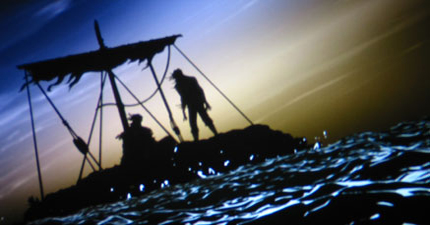
Once the raft is ready, the man sets out towards the mainland. His sanity fades further away as his grief and desperation take further hold of him, and he slowly poisons himself by drinking seawater. He hallucinates, but stays in control enough to reach Davidstown. It looks like the pirates have already arrived, and the man has to do what he can to repel them; but his own actions are borne of madness, and they result in horrors worse that he could have imagined.
It’s a story typical of 1950s-style comics, obviously using sensationalistic EC Comics as particular inspiration. Viewers acquainted with such pulpy fare may no doubt see much of the ending coming, but fortunately the artwork and gripping (if purposefully overwrought) narration are enough to distract one from the obviousness of the plot. Scottish actor Gerard Butler (300, The Phantom Of The Opera) is the narrator, and he brings plenty of gruesome passion to the project. This tale calls for a certain amount of scenery chewing, and he does so while still showing a proper amount of restraint.
One area that this production does not show restraint is in the area of gore. Snyder wanted his Watchmen film to be at least as visceral as it was intellectual, and this off-shoot does nothing to soften that take on the material. Broken bodies, graphic violence, and a tragic finish make this cartoon adults-only. All this wouldn’t be nearly so effective, though, if the animation was weak. I wasn’t sure how much to expect in that area, but I ended up impressed. The animation is fluid enough to compare favourably to the best direct-to-video titles from the major studios, though certainly falling well short of theatrical quality. This is especially impressive considering that they took the chance on detailed, relatively realistic character models; while this makes the animation more difficult, the animators were up to the task, giving the cartoon a suitable “comic-come-to-life” look. I’m also very grateful that this was done primarily with hand-drawn animation, certainly the right choice to keep the look of a moving comic book.
This release definitely will appeal mostly to those that know the comic and have seen the film, but it does stand alone very well for anyone interested in animated horror or simply cartoons for gown-ups. The true target audience, though, is well served with the bonus features, which add greatly to the whole Watchmen experience…

Is This Thing Loaded?
I was trying to decide on what to do with Under The Hood, the second part of the double feature on this disc. Is it a part of the main feature, or a bonus item? Well, the spine of the disc’s packaging lists only Tales of The Black Freighter, so I decided that Under The Hood is a supplement. With that said, Under The Hood (37:36) actually runs even longer than the supposed main feature on this disc, and fills in an important part of the story that could not be covered in the film. This featurette, naturally also presented in high definition, is based on supplemental text materials found in the Watchmen comics, exploring the history of the early superheroes, as presented as excerpts from a book written by the original Nite Owl, Hollis Mason (played by Stephen McHattie). For the DVD and Blu-ray, a more video-friendly format is used, with a “current” (mid-1980s, per the original story) episode of a newsmagazine show looking back on a story done ten years earlier, when Mason’s book was released. So, in this featurette, we see an interviewer sitting down with Mason at the Gunga Diner, discussing Mason’s reasons for becoming a superhero, and his views of the current state of the world. Much of Mason’s dialog comes straight out of Watchmen. Additionally, there are photos and short video segments from the “olden days” of superheroes, and additional interview segments with primarily Sally Jupiter (Carla Gugino), but also a few other characters. These additional interviews touch on some of the other supplements from the comic, such as Wally Weaver’s discussion on Doctor Manhattan. There are a lot of cool bits in here, right down to some vintage commercials (both real and newly produced). While the description on the back of the case says this is a mixture of live action and CGI, this is really primarily a live action featurette, and very cool for Watchmen fans. This one is rated PG, by the way.
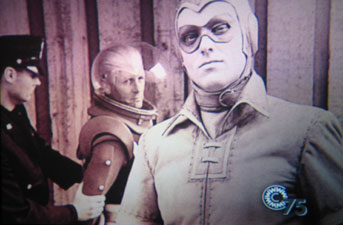
Story Within A Story: The Books Of Watchmen (25:01), another hi-def bonus, is more of an explanation for the existence of the two main features, as opposed to a “Making Of” piece. Regardless, there are plenty of behind-the-scenes looks at the making of Watchmen, as well as comments from significant people at DC Comics, Watchmen artist Dave Gibbons, and several actors from the film. Zack Snyder is often seen, but not heard; but I’m sure we’ll be hearing a lot from him once the Watchmen DVDs roll out.
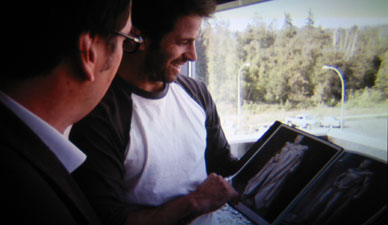
Watchmen Motion Comic: Episode One (25:31) is a presentation of the entire first chapter. I passed on getting the DVD of the complete tale, but was happy to get a sampling here. While I’m not enthralled with the very idea of “motion comics” myself, I have no problem with others enjoying them, and I was pretty impressed by the job that was done here. There is a lot more animation than I expected; but it would have gone over so much better with a complete voice cast, or at least a female speaker to handle the ladies’ roles.
First Look At DC Universe’s Animated Green Lantern (10:12) is the same look we got on the Wonder Woman disc. I watched it again anyway, as I’m pretty pumped about that July release.
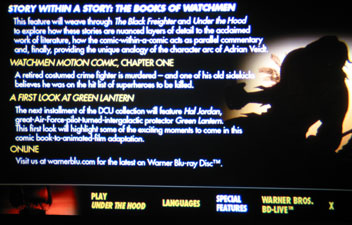
And, as mentioned, there is a Digital Copy available as well, on a separate disc. It looks like it includes both The Black Freighter and Under The Hood, judging by what it says on the disc.

BD-Live Exclusives: It took just a few minutes to register for Warner’s BD-Live Community. After giving my e-mail address on my TV screen, I went to their home page, where a trailer for Watchmen: Tales Of The Black Freighter was playing. Meanwhile, I went to my computer to complete my registration from my web browser, after Warner sent me a link via e-mail. With all that settled, I tried to enjoy the BD-Live content. I was able to play some Trailers, of which Warner Home Video had quite a few offered, though only filling a small box in the center of my television screen. I then eagerly went to find the exclusive videos regarding this particular Blu-ray release… and got nothing.
This Blu-ray’s BD-Live features are supposed to allow you to download two videos. One is a featurette with Zach Snyder called The Why Of Watchmen, and the other is a deleted scene featuring the two Bernies, who barely appear in the final film but figure to show up a lot more in the upcoming director’s cuts. Unfortunately, neither video was available for me to watch, even though it is now past the street date for this disc. Well, hopefully I can see them soon. Of course, once the expected monster ultimate Blu-ray for Watchmen comes out, I’m sure I’ll have all the special features I can handle. But the no-show of these anticipated BD-Live featurettes just makes me wish even more that they would just put the darn content on the discs to start with.
Case Study:
The standard Blu-ray case comes with an identical, simple non-embossed O-sleeve. The case has spots for a disc on either side, in order to accommodate the Digital Copy disc. There is an insert concerning the Digital Copy, and one advertising the Watchmen collected editions and the video game base on the movie.
Ink And Paint:
The VC-1 1080p video is an impressive as it should be. The 2.4:1 digital-to-digital transfer for Black Freighter is flawless, with deep, deep colors and no noticeable artifacting of any kind. And the blacks are oh-so-black, as intended. I noticed no compression artifacts. This is a beautiful disc to watch… until you get to the other feature. Under The Hood is presented in a 4:3 image, in keeping with its faux vintage look. To this end, the interview footage is purposefully made to look older and scratchier, so there is a lot less hi-def “pop” than what you’ll see elsewhere on the disc.

Note that the actual Blu-ray has images are sharper than what is seen in these screen captures.
Scratch Tracks:
As per Warner’s custom, they have included separate lossless Dolby TrueHD and lossy Dolby Digital tracks. The Warner Premiere productions generally get pretty decent sound budgets, making direct-to-video projects like this often sound way better than expected. There are true separation effects at work here, and impressive envelopment by the audio track, pulling the viewer fully into the tale of The Black Freighter. (Naturally, there was less need to be as impressive with Under The Hood). There are English subtitles.

Final Cut:
Even someone with no interest in Watchmen could enjoy the riveting Tales Of The Black Freighter, while Under The Hood is for Watchmen buffs only. As someone who has now read the comic a few times, and thoroughly enjoyed the theatrical film, I loved every minute of this Blu-ray. Even the Story Within A Story featurette is a great bonus, acting as a look at the movie as much as the two featurettes on this disc. I’ll really looking forward to seeing Zack Snyder’s ultimate cut of the film, which will include at least some of the Black Freighter footage, but I expect that this disc will be the only way to see most of this material. If you want to collect everything Watchmen, you can rest assured that this disc is a great little purchase; but it you’re content to see what you can in the ultimate cut of the film, then you could likely give this a pass.
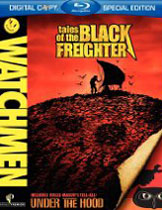 | ||
 |







